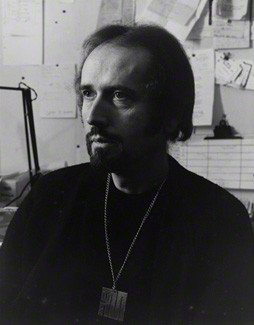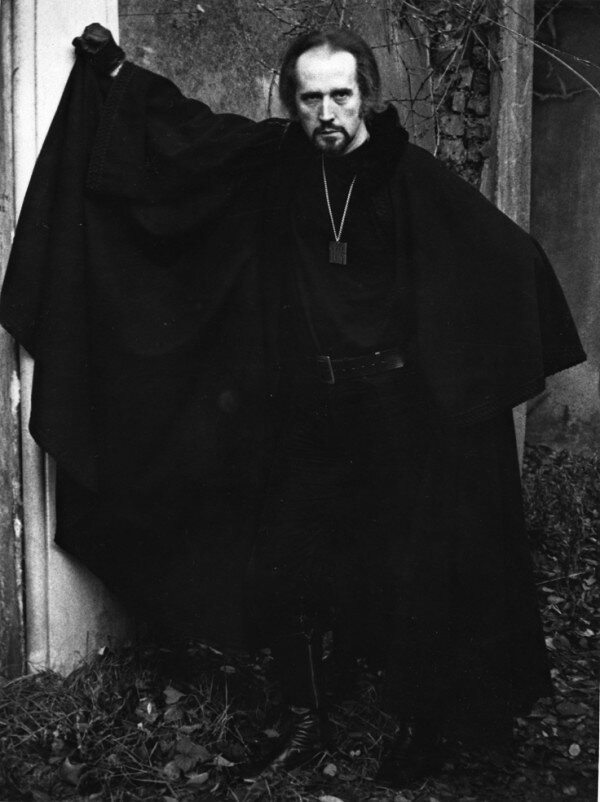Mike Raven (Austin Churton Fairman)

In the early 1960s, still using his real name, Mike Raven began working for BBC radio, presenting talks and, occasionally, Woman’s Hour. However, when his cousin, the Liberal Party politician Oliver Smedley, founded the pirate radio station Radio Atlanta, he joined the station as a disc jockey, broadcasting from the ship Mi Amigo moored off the coast of Frinton-on-Sea. At that point, he began using the name Mike Raven, and presented shows which focused on his love of American blues, rhythm and blues and soul music, of which he owned a large record collection. In 1964 he married Mandy Kilbey, sometimes presenting radio programmes jointly with her; they later had two sons. With Smedley, Mike Raven became an active campaigner lobbying Parliament for the legalisation of the pirate radio stations, until Smedley was accused of causing the death of rival radio entrepreneur Reg Calvert by shooting him with a shotgun; he was later acquitted on the grounds of self-defence. Raven then moved to another pirate station, Radio Invicta, which broadcast from a wartime defence tower on a sandbank in the mouth of the River Thames. The station was later known as Radio King and Radio 390. There, he was programme controller and presented a daily R&B show until November 1966.
A compilation album, The Mike Raven Blues Show, billed as “twice voted top pirate radio show”, was issued on the Xtra label, a subsidiary of Transatlantic Records, in 1966. It featured recordings by Texas Alexander, Blind Lemon Jefferson, Gus Cannon, Robert Johnson, Speckled Red, Victoria Spivey, Lead Belly, Big Bill Broonzy, Sonny Boy Williamson, Brownie McGhee, Lightnin’ Hopkins, and Elmore James. After working for a short time for Radio Luxembourg, presenting an EMI-sponsored soul show, he joined BBC Radio 1 – the first national radio channel in the UK playing predominantly popular music – for its launch day in September 1967. The Mike Raven Blues Show debuted on the first day of Radio 1, and was a regular feature, usually on Sunday evenings, until November 1971, eventually expanding to a two-hour slot. Raven was regarded as a leading authority on the subject, and the show was highly influential in promoting the music of African American culture within the UK, being described as “essential listening for every self-respecting blues fan”.
In 1971 Mike Raven decided to leave radio and to return to acting, combining his former career with his passion for the occult to work in horror movies. The pre-publicity for these films centred on Raven’s interests in the occult – he reputedly always dressed in black, often with a matching cloak. He first appeared as Count Karnstein in the Hammer horror film Lust for a Vampire (1971) but suffered the indignity of having his voice re-dubbed. He then moved to the Amicus production company for I, Monster (1971), and worked with producer Tom Parkinson on Crucible of Terror, in which he played a mad sculptor. The filming introduced him to Cornwall, where he moved with his family to live in a converted 17th-century pigsty at Penpol, Lesnewth. Mike Raven and Parkinson collaborated again on Disciple of Death (1972), which Raven partly financed. However, its poor commercial performance effectively ended his acting career – one critic described the film as “so incoherent that it comes across as a Dada nightmare”. He also appeared on the music show 2 G’s and the Pop People (1972), performing a version of the “Monster Mash”.
Mike Raven reverted to using his real name in 1974, and began to produce carvings in wood and granite, combining religious and erotic imagery. In 1977 he moved with his family to South Penquite, near Blisland on Bodmin Moor, where, with no prior knowledge, he began sheep farming, eventually establishing a successful farm. Later, he had to give up farming because of a heart condition, turning instead to his art. He determined not to sell any work until he had enough for an exhibition, but was initially thwarted by the unexpected deaths of two of his sponsors, the critic Peter Fuller and then the artist Christina Hoare. His first show of sculptures was eventually arranged in Cornwall, but shortly before it was due to open the sponsors pulled out on the grounds that some of the works were in bad taste. They were eventually, and successfully, displayed in the crypt of St George’s Church, Bloomsbury, in 1990, and later at the Penzance Gallery. One of his pieces, The Deposition from the Cross, was later exhibited in the Images of Christ exhibition of 20th century religious art staged at Northampton and St Paul’s Cathedral, London. A series of commissions followed, from around Europe. On the 25th anniversary of the start of Radio 1, in 1992, it was at first rumoured that he was dead, and someone making personal appearances as Mike Raven was exposed as a fraud. Eventually an appeal for information about him was heard by a butcher in Cornwall, who revealed Fairman’s change of name and whereabouts. Mike Raven died in 1997, and was buried in a grave he had dug for himself on Bodmin Moor.
Born
- November, 15, 1924
- United Kingdom
- London, England
Died
- April, 04, 1997
- United Kingdom
- Blisland, Cornwall


